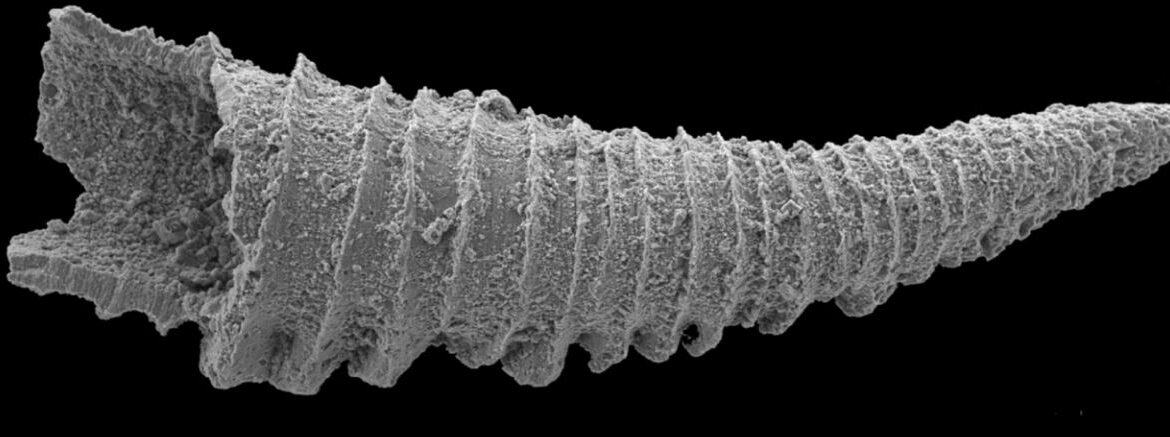Table of Contents
A picture of a tiny, 2-millimeter-long fossil is on the cover of the March 2024 issue of Palaeworld. International scientists led by Tartu University paleobiologist Olev Vinn made a remarkable discovery of new species of marine animals that adapted to life in muddy shallow waters of the Baltic Sea’s predecessor.
New Species
The study discovered two new cornulitid species – a genus of tiny tubeworms abundant in the world’s oceans at the time – that had evolved from their larger relatives living on hard ocean substrates to thrive in the new environment: the shallow, muddy seafloor of the Baltica paleobasin.
Vinn has been studying Ordovician (485-443 million years ago) cornulitids from Estonia for decades and has published extensively on them, but he still believes more research is needed to understand the diversity and ecology of this mysterious group.
Cornulitids as primitive tentaculitoid tubworms are difficult to categorize as they went extinct, leaving no living descendants to study. “The extinction of tentaculitoids during the Middle Jurassic (174-163 million years ago) could have been caused by ecological pressure from serpulid and sabellid segmented worms, their thicker-skinned successors, and the first tubeworms to build fully biomineralized skeletal tubes,” Vinn said.
Vinn has placed the cornulitids in an order of encrusting tentaculitoid tubeworms, which were probably ancestors of the free-living tentaculitids, themselves an extinct genus of conical shell fossils of uncertain affinity.
Cornulitids played an important part in the marine ecosystem by providing food and sometimes substrate for other species. They were also often part of the reef fauna, according to Vinn.
The team of scientists was able to understand the adaptation mechanisms of these organisms to their specific ecological niche on Baltica during the Great Ordovician Biodiversification Event (GOBE) by studying intricate designs of their tubes and body structures.
Baltica paleocontinent
The Baltica paleocontinent is a 3-billion-year-old rock mass that split from the larger paleocontinent near the South Pole and began its journey northward from high southern latitudes toward the equator, drifting during the Ordovician period roughly where Australia is located today.
Baltica is essentially the same land mass that supports most of northern Europe today: the area stretching from Norway to the Ural Mountains, including Scandinavia, the Baltic States, westernmost Russia, Ukraine, and northern Poland.
Scientists have explained the GOBE by two processes: sea levels began to rise simultaneously worldwide and created extensive inland seas on prehistoric continents, and the climate began to cool.
An extensive inland sea also formed on the vast, relatively flat surface of Baltica. However, during the Ordovician, climate in Baltica got a little warmer because of drift of the continent towards the equator, and by the end of Ordovician Baltica was in the tropics.
The Ordovician “Baltic Sea”
The Baltica paleobasin that later became the Baltic Sea, covered the vast area from Scandinavia to northwestern Russia, submerging the territories of today’s Baltic states under warm, tropical waters.
Northern and central Estonia and the Gulf of Finland were its shallowest zones, forming the coastal seas around Finland’s uninhabited stony land.

“Some areas would have been similar to the depth of the modern Baltic Sea, which would have been an average of about 60 meters.
“Shallow marine environments often have murkier water compared to deeper ones, but in general, the Baltica paleobasin had slightly cleaner water than the modern Baltic Sea, which can be compared to the tropical seas around the Bahamas,” he said.
The Baltic Basin had normal salinity because to its higher exposure to oceanic waters, while the present Baltic Sea has low salinity due to its protection from the ocean and freshwater inputs, according to Vinn.
Estonia was thus covered by shallow coastal waters very similar to the modern Baltic Sea: with flat seabed topography and soft, muddy bottoms, but with higher salinity and warmer surface water temperatures.
Life on land had not yet evolved during the Upper Katian (450 million years ago), but if you were to dive into the pleasantly warm, tropical waters of the Baltica paleobasin at the time these cornulitids lived, you would encounter marine life that was already not so different from what we know today.
“The seas teemed with an incredible variety of life forms. Among the largest organisms, there may have been early forms of jawless fish or giant arthropods, such as trilobites. The largest were the predatory nautiloids, which typically grew to more than two or three meters in length. The smallest would probably be tiny animals such as plankton or tiny invertebrates,” he explained.
Baltica has “archived” its paleobasin history in a sequence of sedimentary rocks very well due to its relatively stable environment over millions of years with little tectonic activity.
Clay sample reveals new life forms
Layers of carbonate mineral rocks with earthy mixtures of fine-grained minerals and clay is what now remains of the Ordovician inland sea in northern and central Estonia.
The Sutlema Quarry, a large working quarry in northwestern Estonia, is only about 6 meters deep and exposes the boundary strata of the Nabala and Vormsi regional stages in the upper 1.33 meters.
The so-called Kõrgessaare Formation within the upper layer (a brownish to bluish-grey muddy limestone with thin wavy beds of calcareous marl) is a fossil-rich layer containing ancient corals, gastropods (ancient slugs and snails), cephalopods (ancient mollusks, such as squid or cuttlefish), rhynchonelliform brachiopods (ancient clams).

The researchers took a 2.5-kilogram clay sample, essentially a slice of the muddy bottom environment of the proto-Baltic Sea.
The clay was then soaked in water for 24 hours, washed through three sieves, the residue examined under a microscope, and the fossils picked by hand.
The team found about 40 fossils of complete tiny cornulitids and several fragments of larger ones. The specimens were coated with platinum and photographed with a scanning electron microscope (SEM) at the RAS paleontological institute and are now deposited at the TalTech department of geology.
The macro images show the intricate structures of the cornulitids with their unique horned tubes in microscopic detail, while the research delves into the taxonomy, morphology, and ecological significance of these finds.
Cornulitids
Cornulitids’ biological affinities have been debated for over two centuries. Vinn suggested in his earlier publication that they belong to the Lophotrochozoa clade – which includes annelids, mollusks, moss animals, and flatworms – and presumably represent stem-group phoronids, also known as horseshoe worms.
Cornulitid tubeworms have a conical body with a lophophore – a feeding organ similar to that of brachiopods and bryozoans. To feed, they would extend their lophophore from the protective tube (thin calcitic shell) to capture suspended particles and small organisms from the surrounding water.
The tiny creatures usually attached themselves to hard substrates such as rocks or shells. Some of them also inhabited the bodies of other organisms, such as stromatoporoids, extinct sea sponges, corals, and moss animals. “As endobiotic symbionts they were living, for example, inside the shells; so embedded within the host’s skeleton,” Vinn gave an example.

The new study suggests that cornulitids adapted not only attaching to hard substrates, but also living within softer sediments.
The specimens found in the sample all showed a unique adaptation mechanism, Vinn explained. “They were all initially attached to small hard substrates such as shell debris, for example, but when they would grow larger than their substrate, they may have anchored themselves within mud or silt, so utilizing their unique adaptations to thrive also in such environment.”
The tiny species of cornulitids examined in the study adapted to live on surfaces, which were even smaller than their own bodies. “They preferred attaching themselves to substrates that were often smaller than themselves, sometimes less than a millimeter in size. This behavior suggests a specialization for particular microhabitats,” Vinn said.
“They attached themselves by using a combination of organic and mineral secretions and when they fossilized, they often remained attached to that substrate, preserving their original position. They also often fossilized together with the organisms to which they were attached, all of which gives valuable insights into ancient marine ecosystems,” he added.
The findings corroborate the GOBE hypothesis, that there was an explosion of biodiversification during the Ordovician period, wiping out the earlier, alien-looking life forms that lived in the Cambrian period and replacing them with marine fauna that looked quite similar to what we know today.
The new study revealed not just the diversity and abundance of the cornulitid fauna in Baltica paleobasin, but also the existence of links between the Late Ordovician Baltica and Laurentia (North America’s ancient geologic core).
“The movement of organisms between different continents during the Ordovician period is a topic of ongoing debate among paleontologists. It seems that the swimming larvae of cornulitids, similarly to other groups of zooplankton, could have dispersed via ocean currents,” Vinn suggested.
Today, the center of Estonian paleoecological studies of marine organisms is located at the Institute of Ecology and Earth Sciences at the University of Tartu, which also plays a key role in the study of cornulitid tubeworms worldwide.
“Estonia has now a strong tradition in paleontology and the study attests to the uniqueness of our geological and paleontological heritage,” Vinn said.
This article was originally published on the Estonian Public Broadcasting online news portal ERR . Written by Kristina Kersa, editeb by Marcus Turovski.
If the stories of the past fascinate you and uncovering ancient secrets excites you, explore more historical treasures on our webpage and read about How did transnational knowledge transfer between Eastern European cultures of history during the interwar period?
 Back
Back



